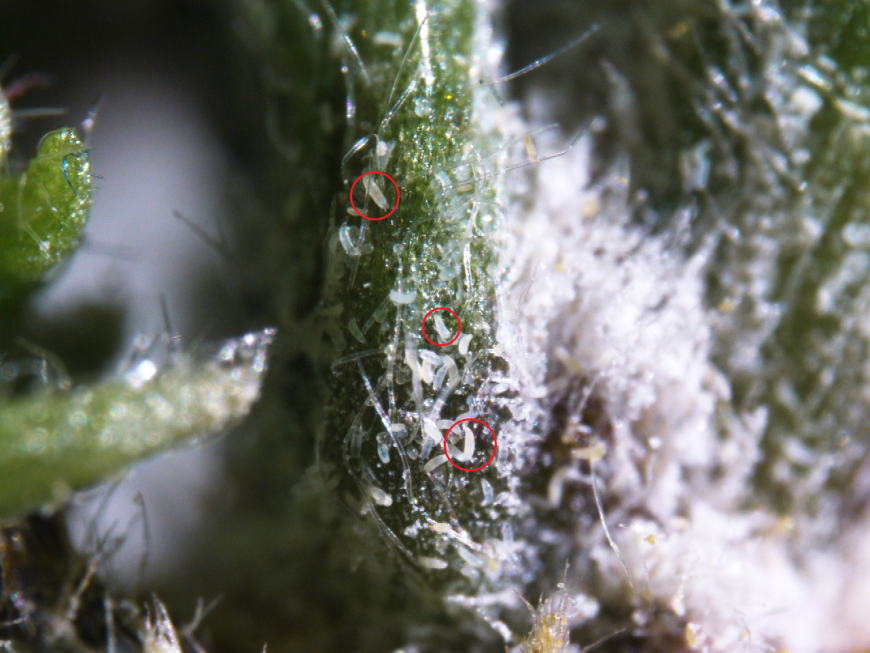Old man's beard mite
History in New Zealand
The old man’s beard mite is native to Europe from France to Romania. It was first imported into containment by Manaaki Whenua - Landcare Research in 2011. However, it was difficult to establish a colony in the laboratory, so host specificity testing was carried out in Serbia. Permission to release this mite was granted by the EPA in 2018. The first viable laboratory colony was established with the importation of new material from Serbia in 2019, and was removed from containment after receiving MPI approval a few months later. This mite has not been used as a biocontrol agent anywhere before. Field releases began in August 2021 and will continue until the mite is widely established.
How would I find/recognise it and what is its lifecycle?
You won’t be able to see these microscopic mites with the naked eye. Under a microscope, they are creamy-white in colour and cigar-shaped.

Image: old man's beard mites emerging from a stem bud. Individual mites are very small and cigar-shaped (see mites marked with red circles).
The best way to detect their presence is to look for the distinctive deformed leaflets that form as a result of the mites’ feeding.
Image: old man's beard deformed leaflet caused by mites.
Due to their small size, the life cycle of this mite is not yet well known. Nonetheless, it is expected that several overlapping generations of mites live, breed and feed in the buds of old man’s beard over spring and summer when the shoots and leaves are growing. The mites will disperse by a phenomenon known as ‘ballooning’ where they move with air currents to colonise new old man’s beard plants. We already have evidence that the mites can travel at least 100 m from the original colony. In winter, when old man’s beard is dormant, the mites live predominantly inside the stem buds.
There are other species of larger mites naturally found on old man’s beard in New Zealand that are visible with the naked eye. The only way to confirm the presence of the old man’s beard mite is to look for the leaf growth abnormalities.
How does it damage old man’s beard?
Feeding by the mites induces growth abnormalities, or galls on the old man’s beard developing shoot tips and leaves. The leaves will look atrophied and curled. The formation of galls reduces the growth rate of the weed and may cause shoots to die off prematurely. The deformed leaves can easily be confused with damage done by late-frost events and leaf roller caterpillars. The deformed leaflets are easy to differentiate from other old man’s beard agents.
See Old man’s beard leaf fungus, Old man’s beard leaf miner and Old man’s beard sawfly.

Image: old man's beard deformed leaflets caused by mites.
Will it attack other plants?
The old man’s beard mite is highly host specific and it is highly unlikely that it will attack anything other than old man’s beard (C. vitalba). An exotic, ornamental Clematis species (Clematis stans) may be attacked to a lesser degree. Host specificity tests indicate that the risk to native Clematis species and other ornamental species is insignificant.
How effective is it?
It is too soon to know what impact these mites will have in New Zealand. However, the closely related broom gall mite, Aceria genistae has started to have major impacts on broom since it was introduced in 2008. We hope to see similar results with the old man’s beard mite in coming years.
Eriophyid mites (such as the broom gall mite and the old man’s beard mite) have been increasingly studied for their use in biological control programmes around the world and are now viewed as potentially highly host-specific and damaging agents.
How can I get the most out of it?
The mites disperse by ballooning on wind currents. Like the broom gall mite, we believe the old man’s beard mite will readily and quickly disperse to surrounding infestations from the original release sites.
How do I select a release site?
Read Guidelines for selecting release sites for biocontrol agents.
How do I collect it for release at other sites?
Redistribution strategies are still to be developed. It is not advisable to cut infected plant material to relocate the mites because they will die very quickly on cut shoots as they dry out. Instead, it is likely that whole infested plants will need to be moved, and perhaps that potted plants will need to be grown especially for this purpose, an activity which will require an MPI exemption.
How do I manage the release sites?
Avoid any activities that will interfere with the mites, such as herbicide application. If you need to undertake control measures, then avoid the release site.
Key contact





